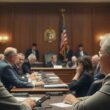A recent survey conducted as part of the international study “Worlds of Journalism” confirms that Austrian journalists are clearly positioned to the left of the center and the trend is intensifying. On a scale of 0 (left) to 10 (right), the average political self-assessment value is 3.6, which is lower than the value of the general population and the previous survey in 2015.
Notably, this trend is not new. Older studies have shown that many journalists have a strong affinity with the Greens. In Switzerland, around 76 percent of media professionals recently identified as “leaning left.” This growing gap between published opinions and the reality of the population is becoming increasingly apparent.
While scientists like Josef Seethaler (Austrian Academy of Sciences) and Vinzenz Wyss (ZHAW) attempt to relativate the significance of these self-assessments, other studies reinforce the findings with concrete party preferences. In the past, approximately one-third of Austrian journalists sympathized with the Greens, which is several times higher than the nationwide election results of this party.
In Germany, the tilt is even more pronounced. According to the long-term study “Journalism and Democracy” (2024, TU Dortmund), 41 percent of journalists identify with the Greens. In contrast, only eight percent sympathize with the CDU and three percent with the FDP.
Parallel to this, the journalistic self-understanding as “guardians of democracy” is increasing. However, this role raises questions: Who oversees the overseers and from what ideological perspective? Critics see the prevailing political homogeneity as a threat to diversity of opinion.
In 1994, historian Rainer Zitelmann warned in his book “Wohin treibt unsere Republik?” of a structural leftward tilt of the media, driven by the cultural influence of the 68er movement. His analysis: Media not only shape reporting but set the framework of public discourse through topic selection, tone and perspective, often favoring left-wing narratives.
Zitelmann’s appeal remains relevant today: Only a truly pluralistic media landscape can ensure that different opinions are heard and, thus, genuine freedom of thought is guaranteed.
More on the topic – Faeser and the Compact-Verbot: From Expropriation to the Reichsschrifttumskammer.





